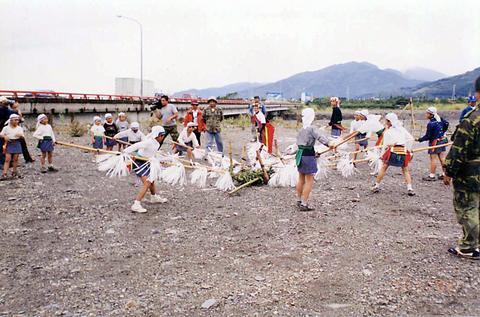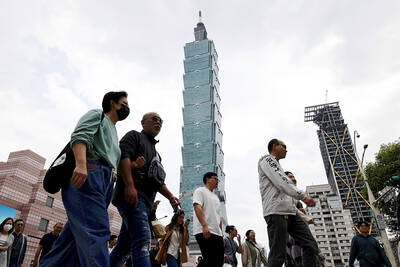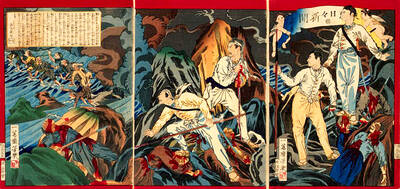According to Puyuma tradition, when a teenage male reaches puberty he should spend half a year, every year until marriage, preparing to be a man. In the past, teenage boys from the Puyuma Aboriginal villages would leave their families to live and study together under the watchful eye of an elder. The exercises, mostly aimed at perfecting their hunting ability and house building skills, were necessary requirements of becoming an adult and providing for one's family.
At the end of their half-year training, the young men would return home and take part in one more test: the ceremonial slaughter of a monkey. In addition to the Harvest Festival held at the end of the summer, the Monkey Festival is organized and attended by the entire village. Although it has been modified greatly over the years, the ritual is still of major significance to the Puyuma and it is also open to the public.

PHOTO COURTESY OF BEINAN TOWNSHIP
The songs and dances during the ceremony are the same as those used traditionally to simulate the behavior of a monkey. The major difference in the ritual comes after the singing and dancing when the boys come to the center of the circle and use spears to stab a monkey to death. After the persistent lobbying of animal rights groups, real monkeys are no longer used in the ritual killing and in their place are grass dolls. After the killing ritual is re-enacted, another rite is performed to mourn the spirits of the monkeys.
Visitor involvement in the ceremony is left up to the discretion of each individual, said Shu Jan-mei (
A week after the boys return from their manhood training, a three-day Hunting Festival takes place when the men retreat to the nearby mountains.
Visitors do not normally attend the hunting excursion but there is a ceremony open to the public honoring the men upon their return home. The women and children serenade the men as they enter the village and treat them to a showcase of song, dance and food.
The Hunting Festival is a joint celebration with several of the villages taking part. It will be held in front of Beinan New Station in the Cultural Park on Dec. 31.
Dec. 31 also marks the Burial Festival for village ancestors and is followed by New Year's celebrations on Jan. 1 and 2 to give thanks to the gods in anticipation of an abundant summer harvest. Marked with singing and dancing competitions, Shu said this is the liveliest of the winter festivals.
The Monkey Festival begins tomorrow morning at 6am and continues until mid to late afternoon. There are 10 villages throughout Beinan Township, Taitung County, that will be performing the ritual and each is open to the public.
Public transportation, however, will not be available and it is recommended to rent a scooter or hire a taxi for the day, depending on how many villages one wishes to visit. The Nanwang village is a five-minute walk north from the train station.
Event Information:
What: Puyuma Monkey and Hunting Festival (
When: Dec. 18 to Jan. 4
Where: Beinan Township (
Cost: Free
Contact: For more information in Chinese contact the office administration in Beinan at (08) 9381368. For further details in English and Chinese on places to stay and where to eat in Beinan and Taitung city check online at http://tour.taitung.gov.tw.
Getting there: (Taipei to Taitung):
By air: More than 20 daily flights to Taitung with Far Eastern Air Transport and UNI Airways Flight (approximately 1hour). Shuttle service to Taitung's new train station provided at airport.
By rail: Three express train services daily between Taipei and Taitung (6 hours). Now a train service available from Taitung to Beinan New Station (approx. 30 mins.), although it is possible to rent a scooter or hire a taxi from Taitung.

In the March 9 edition of the Taipei Times a piece by Ninon Godefroy ran with the headine “The quiet, gentle rhythm of Taiwan.” It started with the line “Taiwan is a small, humble place. There is no Eiffel Tower, no pyramids — no singular attraction that draws the world’s attention.” I laughed out loud at that. This was out of no disrespect for the author or the piece, which made some interesting analogies and good points about how both Din Tai Fung’s and Taiwan Semiconductor Manufacturing Co’s (TSMC, 台積電) meticulous attention to detail and quality are not quite up to

April 21 to April 27 Hsieh Er’s (謝娥) political fortunes were rising fast after she got out of jail and joined the Chinese Nationalist Party (KMT) in December 1945. Not only did she hold key positions in various committees, she was elected the only woman on the Taipei City Council and headed to Nanjing in 1946 as the sole Taiwanese female representative to the National Constituent Assembly. With the support of first lady Soong May-ling (宋美齡), she started the Taipei Women’s Association and Taiwan Provincial Women’s Association, where she

Chinese Nationalist Party (KMT) Chairman Eric Chu (朱立倫) hatched a bold plan to charge forward and seize the initiative when he held a protest in front of the Taipei City Prosecutors’ Office. Though risky, because illegal, its success would help tackle at least six problems facing both himself and the KMT. What he did not see coming was Taipei Mayor Chiang Wan-an (將萬安) tripping him up out of the gate. In spite of Chu being the most consequential and successful KMT chairman since the early 2010s — arguably saving the party from financial ruin and restoring its electoral viability —

It is one of the more remarkable facts of Taiwan history that it was never occupied or claimed by any of the numerous kingdoms of southern China — Han or otherwise — that lay just across the water from it. None of their brilliant ministers ever discovered that Taiwan was a “core interest” of the state whose annexation was “inevitable.” As Paul Kua notes in an excellent monograph laying out how the Portuguese gave Taiwan the name “Formosa,” the first Europeans to express an interest in occupying Taiwan were the Spanish. Tonio Andrade in his seminal work, How Taiwan Became Chinese,